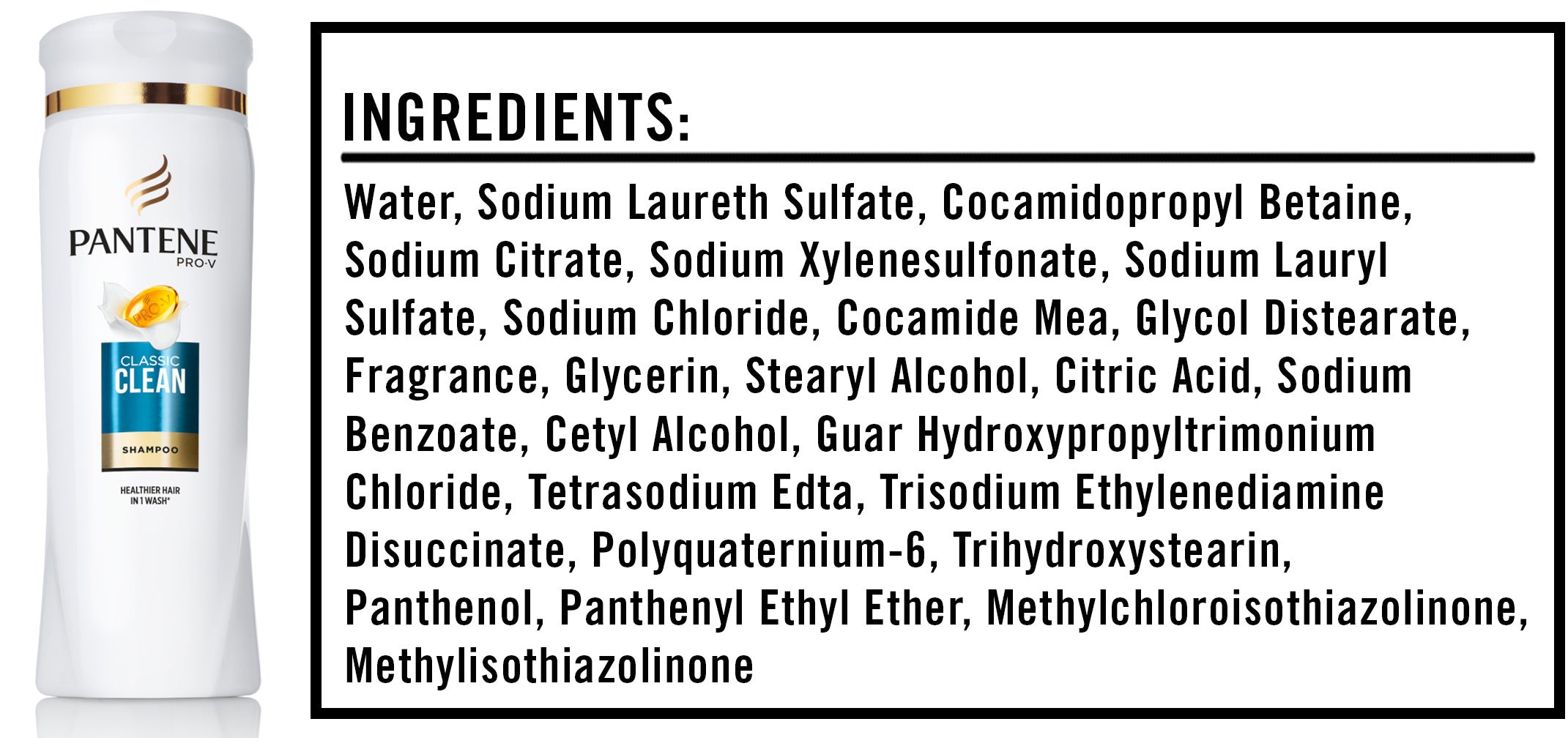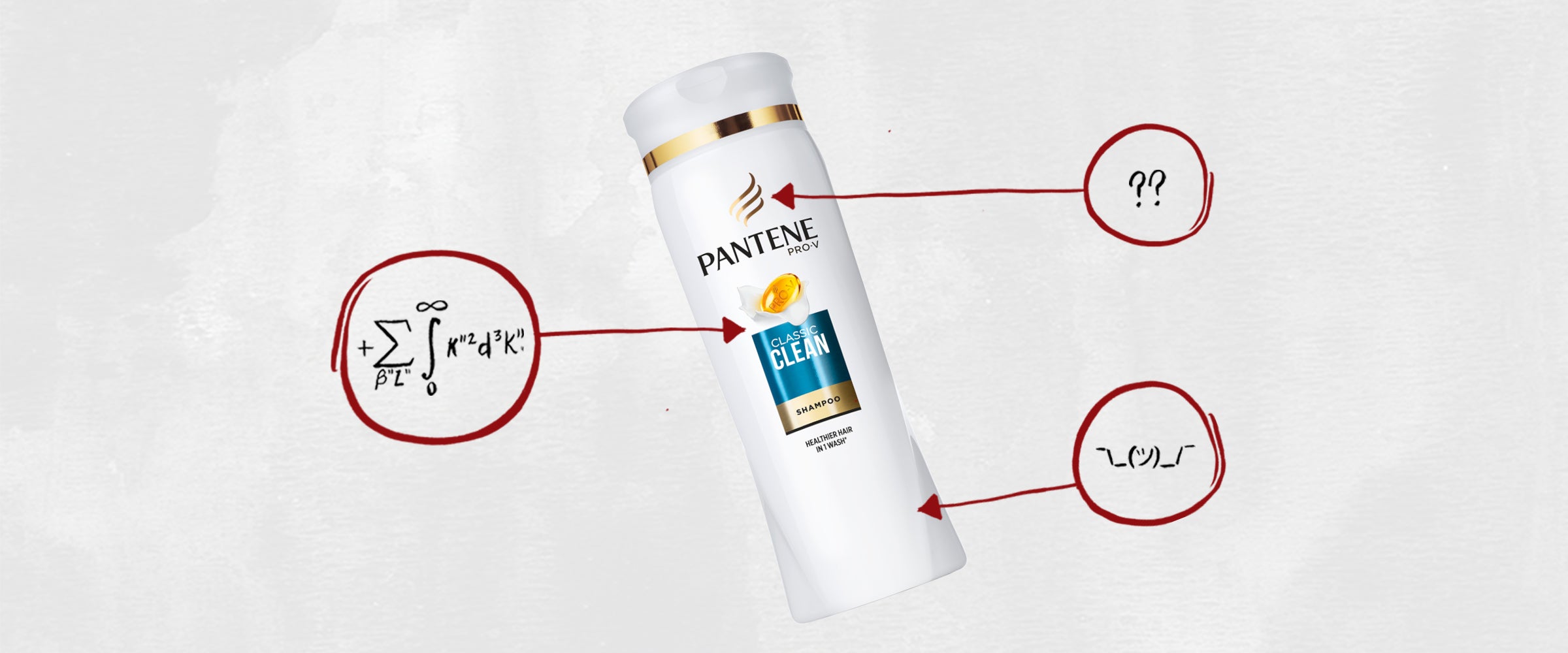We’re often told that you should never eat anything (or put anything on your body) if you don’t recognize everything on the ingredients list. But since most of us have no idea what xanthan gum or potassium benzoate are — or more importantly, what they’re doing to our bodies — we’re decoding the ingredients in the many things Americans put in (and on, or near) themselves.
This edition: Pantene Classic Clean Shampoo, which is made from 24 separate ingredients that we’ve broken down in the exact order they appear on their website.

The Ingredients
1) Water: This comes out of your shower head while you shampoo your hair.
2) Sodium Laureth Sulfate: This is a surfactant, which means it lowers the surface tension between grime and your hair so it can be easily rinsed away. Sodium laureth sulfate in cosmetics has something of a negative reputation, though, since it can be found in strong household cleaners as well, and people tend to believe that it could be too harsh for personal use. However, most research shows that it’s safe when used briefly and rinsed from the skin, although there is some potential for mild to moderate irritation in sensitive people. Whatever the case, because of the recent pushback against sodium laureth sulfate, more and more shampoos and cosmetics are being released without the ingredient.
3) Cocamidopropyl Betaine: Derived from coconuts, cocamidopropyl betaine is another surfactant. In some cases, the production of this ingredient can result in several impurities that are known to cause allergic reactions. So if you break out in hives or redness after using a product with cocamidopropyl betaine, consider switching over to something else.
4) Sodium Citrate: Sodium citrate is a harmless, salt-based ingredient that usually functions as a buffering agent to control the pH level of cosmetics, but it can also be used as a preservative. In simple terms, it helps this shampoo do its job even after hiding in your bathroom cabinet for months and months.
5) Sodium Xylenesulfonate: Sodium xylenesulfonate is yet another surfactant that can also work as a wetting agent, helping the shampoo spread more easily. This ingredient can cause eye irritation — which is common with shampoos — but is generally regarded as safe.
6) Sodium Lauryl Sulfate: This is commonly used in cosmetics as a foaming agent. Similar to sodium laureth sulfate, sodium lauryl sulfate (SLS) has long had a bad reputation for being toxic and possibly even causing cancer. That said, one relatively recent review concludes that the only dangers SLS really poses is as a skin and eye irritant: “The perception that SLS is a threat to human health isn’t scientifically supported, and claims made to the contrary should be regarded as false and misleading.”
Furthermore, as Snopes notes, “Three different agencies — the Occupational Safety and Health Administration (OSHA), the National Toxicology Program (NTP) and the International Agency for Research on Cancer (IARC) — have all rated SLS as being non-carcinogenic.” That said, ingesting sodium lauryl sulfate can cause nausea, vomiting and diarrhea, so no drinking this shampoo!
7) Sodium Chloride: Sodium chloride, or table salt, is often added to cosmetics to increase the thickness. In this case, that can help the shampoo spread throughout your hair.
8) Cocamide MEA: Another ingredient derived from coconuts, cocamide MEA is both a foaming and thickening agent, enhancing the surfactant capabilities of some of the other ingredients. While this ingredient might contain traces of cocamide DEA, a known carcinogen in animals, one decisive report states, “It was concluded that Cocamide MEA is safe as used in rinse-off products and safe at concentrations up to 10 percent in leave-on products.”
9) Glycol Distearate: Glycol distearate is a harmless ingredient that primarily functions as an emollient, softening and smoothing skin and hair by helping them retain moisture.
10) Fragrance: Unfortunately, fragrance recipes are considered to be proprietary information, so finding out exactly what produces the smell of this shampoo is virtually impossible. Sadly, fragrances are a fairly common allergen and can cause rashes and redness in people with sensitive skin, so if you land in that group, consider keeping an eye out for scentless shampoos, instead.
11) Glycerin: Glycerin is a perfectly safe humectant, which means it helps hair obtain and retain moisture.
12) Stearyl Alcohol: This is used as a conditioning agent, coating the hair and keeping it soft, and an emulsifier, helping the multiple ingredients in this shampoo meld together. Studies show that stearyl alcohol is completely safe, too.
13) Citric Acid: Derived from citrus, citric acid is a mild preservative.
14) Sodium Benzoate: Another preservative, sodium benzoate is totally safe in shampoo, but I’d avoid drinking it — not only because shampoo is gross, but because some studies suggest that high amounts of sodium benzoate could be carcinogenic.
15) Cetyl Alcohol: Similar to stearyl alcohol, cetyl alcohol softens the hair without causing any damage.
16) Guar Hydroxypropyltrimonium Chloride: A derivative of guar gum, which is extracted from guar beans, guar hydroxypropyltrimonium chloride is another harmless conditioning agent.
17) Tetrasodium EDTA: This ingredient functions primarily as a chelating agent, a substance that prevents deterioration and mold growth during processing and storage by binding the minerals within the product. The scientific community continues to waver over whether or not it could be dangerous: Oral exposure to tetrasodium EDTA produced adverse reproductive and developmental effects in animals, but a “final report on the safety assessment of EDTA” claims it’s safe for use in cosmetics.
18) Trisodium Ethylenediamine Disuccinate: Another chelating agent, trisodium ethylenediamine disuccinate is considered to be safe.
19) Polyquaternium-6: Polyquaternium-6 is a safe conditioning agent that helps with detangling — i.e., it makes combing your hair much easier.
20) Trihydroxystearin: A combination of glycerin and fatty acids, trihydroxystearin can be used as a skin-conditioning agent, a solvent and a viscosity-increasing agent, making this shampoo thicker and more spreadable. As one safety assessment concludes, “Trihydroxystearin is safe as used in cosmetic formulations.”
21) Panthenol: Derived from vitamin B5, panthenol hydrates hair and improves the shine, strength and softness. By locking in moisture, it can also protect your hair from styling or environmental damage. One study even found that panthenol might help slow down and hide the look of thinning hair.
22) Panthenyl Ethyl Ether: Yet another conditioning agent, panthenyl ethyl ether is made from panthenol and is completely safe.
23) Methylchloroisothiazolinone: This is a strong preservative that prevents the growth of bacteria, yeast and fungi. Unfortunately, methylchloroisothiazolinone is known for being an allergen and can even cause chemical burns in high concentrations. On the plus side, most allergic reactions associated with methylchloroisothiazolinone were related to leave-in products more than 20 years ago, and this ingredient has since been largely limited to rinse-off products in much lower concentrations.
24) Methylisothiazolinone: Often used in tandem with methylchloroisothiazolinone, methylisothiazolinone provokes many of the same concerns.
The Takeaway
All in all, while there are certainly some ingredients in this shampoo that can cause allergic reactions and irritation, especially in people with sensitive skin, the same could be said about most cosmetics. Fortunately, if you use this stuff and your scalp starts itching and/or burning, there are about a million other shampoos on the market.

